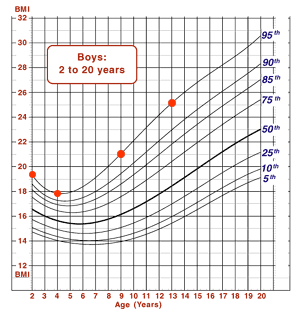Using the CDC BMI-for-age Growth Charts to Assess Growth in the United States Among Children and Teens Aged 2 Years to 20 Years
The Centers for Disease Control and Prevention (CDC) and the American Academy of Pediatrics (AAP) recommend that health care providers in primary care settings use the 2000 CDC growth reference charts for children and teens aged 2 to 20 years to monitor growth in the United States (Grummer-Strawn, Reinold, Krebs, 2010).
The 2000 CDC growth reference charts include the weight-for-age, stature-for-age, and BMI-for-age charts for boys and girls aged 2 to 20 years. This training focuses on using the BMI-for-age growth charts.
What is BMI?
- An anthropometric index of weight and height
Body Mass Index (BMI) is an anthropometric index of weight and height that is defined as body weight in kilograms divided by height in meters squared (Keys et al., 1972).
BMI = weight (kg) / height (m)2
BMI is the commonly accepted index for classifying adiposity in children, teens, and adults.
- A screening tool
BMI is a screening tool used to identify individuals who are underweight, overweight, or obese. BMI is NOT a diagnostic tool (Barlow, 2007).
For example, a child who is relatively heavy may have a high BMI for his or her age. To determine whether the child has excess fat, further assessment is needed. To determine a counseling strategy, assessments of medical risks, behavioral risks, including sedentary time, dietary and physical activity behaviors, and attitudes are needed (Barlow, 2007).
For children and teens, BMI is both sex-specific and age-specific (Barlow, 2007; Hammer et al., 1991; Pietrobelli et al., 1998). Age and sex are taken into consideration for children and teens for two reasons: (1) the amount of body fat differs between girls and boys; and (2) the amount of body fat changes with age.
Read More About...
How BMI Changes with Age for Boys

Because adiposity varies with age during childhood and adolescence, BMI is age-specific. As illustrated on this growth chart for boys, in a growth pattern established along the 95th percentile, BMI-for-age reached a minimum at 4 years of age and then increased with increasing age.
- An indirect measure of body fatness
BMI is not a direct measure of body fatness. However, BMI parallels changes obtained by direct measures of body fat, such as dual energy X-ray absorptiometry (DEXA). BMI can be considered a proxy for measures of body fat.
Note that the accuracy of BMI as an indicator of body fatness (adiposity) varies depending on the degree of body fatness. In other words, among relatively heavy children, BMI is a good indicator of excess body fatness; however, among relatively thin children (those with a BMI-for-age of <85th percentile), BMI is more an indicator of fat-free mass (Freedman and Sherry, 2009). Fat-free mass is total body mass excluding the fat. Fat-free mass includes everything from your skin, bones, ligaments, and tendons, to your organs and water content.
- Page last reviewed: May 9, 2014
- Page last updated: May 9, 2014
- Content source:


 ShareCompartir
ShareCompartir